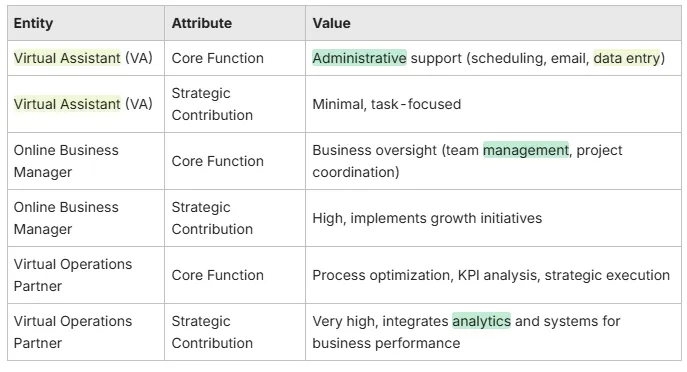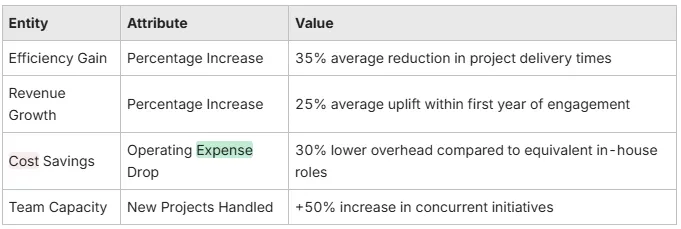Offshore virtual assistant pods offer more than lower costs—they unlock global talent, operational scale, and business resilience. Discover how structured VA pods can future-proof your operations and fuel long-term growth.
From VA to Ops Partner: What Great Virtual Support Looks Like Now with Strategic Virtual Support

Virtual support has evolved from simple task execution to strategic collaboration that drives business growth and operational excellence. As traditional virtual assistants (VAs) encounter limits in scope, virtual operations partners (Ops Partners) deliver high-level oversight, process optimization, and data-driven decision-making. In this guide, you’ll discover:
Core definitions and distinctions between VAs, Ops Partners, and online business managers (OBMs).
Historical drivers and AI-powered transformations shaping modern virtual support.
Key benefits, cost-effectiveness, and scalability advantages of Ops Partners.
Pathways for VAs to transition into strategic roles.
Proven hiring practices and onboarding frameworks.
AI and automation tools that enhance operations workflows.
Real-world case studies demonstrating measurable impact.
By the end, you’ll understand how to leverage virtual operations partners to boost efficiency, foster growth, and outpace competitors through strategic virtual support.
What Is a Virtual Operations Partner and How Does It Differs from a Virtual Assistant?
A virtual operations partner is a strategic collaborator who manages end-to-end business processes, enabling owners to focus on vision and growth. Unlike a traditional virtual assistant who handles discrete administrative tasks, an Ops Partner oversees project management, system optimization, and performance analytics to align daily operations with long-term objectives. For example, while a VA might schedule meetings, an Ops Partner implements workflow automation that reduces administrative load across multiple teams.
What Are the Core Responsibilities of a Virtual Operations Partner?
Virtual operations partners handle a spectrum of strategic duties that ensure seamless business performance:
1.Process Design & Optimization – Document, refine, and automate workflows to eliminate bottlenecks.
2. Project Management – Plan, track, and deliver cross-functional initiatives on time and within budget.
3. Data Analysis & Reporting – Monitor KPIs, generate insights, and recommend actionable improvements.
4. Team Coordination – Facilitate communication and alignment among in-house staff and contractors.
5. Strategic Planning – Translate business goals into operational roadmaps and resource plans.
These responsibilities provide proactive problem-solving and continuous improvement, setting the stage for scalable operations and sustained growth.
How Does an Online Business Manager Compare to an Ops Partner and VA?
An EAV comparison of three remote support roles clarifies their scope and value:

This comparison underscores how Ops Partners blend project leadership and operational insight to deliver far greater strategic impact than conventional VAs or OBMs.
What Skills and Mindset Define a Successful Ops Partner?

Effective Ops Partners combine analytical rigor with leadership acumen and a solutions-first mentality:
-Strategic Thinking – Anticipates challenges and aligns processes with business goals.
-Systems Orientation – Designs scalable frameworks and automations.
-Data-Driven Decision-Making – Uses metrics and dashboards to guide improvements.
-Communication Leadership – Facilitates clarity across remote and distributed teams.
-Proactive Ownership – Takes initiative to resolve issues before they escalate.
Cultivating this skillset fosters trust, demonstrates authority, and ensures that virtual support drives measurable results.
How Has Virtual Support Evolved from Traditional VA Roles to Strategic Operations Partners?
Virtual support has shifted from simple administrative outsourcing to comprehensive operational partnerships. Early adopters delegated email and calendar management to VAs; today's businesses seek remote collaborators who can implement growth strategies. This evolution stems from technological advances, changing workforce models, and the need for agile, cost-effective operations.
The Evolution of Virtual Support
The shift from traditional virtual assistant roles to strategic operations partners is driven by technological advancements, changing workforce models, and the need for agile, cost-effective operations. Businesses are increasingly seeking remote collaborators who can implement growth strategies, moving beyond simple administrative tasks.
This research supports the article's discussion of the evolution of virtual support and the factors driving this change.
What Business Drivers Have Accelerated the Evolution of Virtual Support?
Key factors pushing virtual support toward strategic ops include:
1. Remote Work Adoption – Distributed teams require robust virtual coordination.
2. Digital Transformation – Cloud tools and integrations enable end-to-end online workflows.
3. Cost Pressure – Outsourced expertise reduces overhead compared to in-house hires.
4. Competitive Differentiation – Faster execution of growth initiatives drives market leadership.
How Has AI and Automation Transformed Virtual Assistant Capabilities?
AI-powered features have elevated virtual support from manual data entry to smart process management:

By offloading repetitive tasks to AI and automation, Ops Partners devote time to system design, KPI reviews, and strategic planning.
Why Is Strategic Support Now Essential for Modern Businesses?
Strategic virtual support addresses critical needs:
-Agility – Rapidly adapts processes to market shifts.
-Scalability – Builds frameworks that grow with customer demand.
-Resource Optimization – Directs human and digital assets where they yield the highest ROI.
-Risk Mitigation – Proactively identifies operational vulnerabilities before they escalate.
What Are the Key Benefits of Hiring a Virtual Operations Partner for Your Business?
Engaging a virtual operations partner delivers multifaceted advantages that fuel efficiency and growth from day one. By integrating strategic support with hands-on execution, businesses unlock new performance levels without the fixed costs of in-house hires.
How Does an Ops Partner Improve Efficiency and Productivity?
Virtual operations partners streamline workflows and eliminate redundant steps through:
-Standard Operating Procedures (SOPs) that ensure consistency.
-Automation of routine tasks to reduce manual errors.
-Centralized dashboards for real-time monitoring.
-Delegated oversight that frees executives to focus on core priorities.
This efficiency gain translates into shorter project cycles and higher team output.
In What Ways Does an Ops Partner Enable Scalable and Sustainable Growth?
By constructing robust systems and growth-ready infrastructure, Ops Partners:
1. Implement repeatable processes that support rising demand.
2. Establish knowledge repositories and training for rapid onboarding.
3. Monitor capacity and forecast resource needs.
4. Design scalable technology stacks to handle volume surges.
These capabilities position businesses to scale confidently without operational breakdowns.
How Is Hiring an Ops Partner More Cost-Effective Than In-House Support?
Virtual operations partners deliver executive-level expertise at a fraction of full-time salaries. Outsourcing strategic support reduces recruitment time, benefits overhead, and office expenses while maximizing output, providing high-level operational management without the full cost of an internal hire.
Cost-Effectiveness of Virtual Operations Partners
Virtual operations partners offer significant cost savings compared to in-house operations roles. Outsourcing strategic support reduces recruitment time, benefits overhead, and office expenses while maximizing output, providing executive-level expertise at a fraction of the cost.
This citation supports the article's claims regarding the financial benefits of hiring virtual operations partners.

What Specialized Skills Does an Ops Partner Bring to Your Team?
Virtual operations partners contribute niche expertise across domains:
-Advanced project management methodologies (Agile, Kanban).
-Data visualization and dashboard creation.
-API integrations and workflow automation.
-Financial forecasting and budget tracking.
-Vendor and contractor management.
These specialized skillsets augment internal capabilities and elevate organizational maturity.
How Can Virtual Assistants Transition to Become Strategic Virtual Operations Partners?
VAs aiming for higher impact can evolve into Ops Partners by building new competencies, earning certifications, and adopting a proactive mindset focused on business outcomes rather than task completion.
What Skills and Certifications Are Needed to Become an Ops Partner?
Aspiring Ops Partners should pursue:
-Certified Project Management (PMP, PRINCE2).
-Online Business Manager accreditation.
-Automation and RPA tool certifications.
-Data analytics courses (Excel, Power BI, Google Data Studio).
-Leadership and communication workshops.
How Can VAs Develop a Strategic Mindset for Business Growth?
Shifting from execution to strategy requires:
1. Learning to analyze KPIs and translate data into recommendations.
2. Practicing risk assessment and contingency planning.
3. Shadowing business leaders to understand decision-making priorities.
4. Proactively proposing operational improvements based on observed pain points.
What Networking and Career Paths Support This Transition?
Building a professional network accelerates progression:
-Joining OBM and VA communities on LinkedIn and specialized forums.
-Attending virtual summits on operations management and automation.
-Seeking mentorship from experienced online business managers.
-Contributing case studies to industry publications for credibility.
These steps expand opportunities and showcase emerging leadership in virtual support.
How Do Businesses Find and Hire the Right Virtual Operations Partner?
Identifying a qualified Ops Partner involves clear criteria, targeted search channels, and structured onboarding to ensure alignment from day one.
What Should Businesses Look for When Hiring an Ops Partner?
Key qualifications include:
-Proven track record in process improvement and project delivery.
-Strong data analysis and reporting capabilities.
-Familiarity with core tools: Asana, Trello, Zapier, Slack, Monday.com.
-Excellent communication skills and cultural fit.
References attesting to strategic impact and ROI.
Evaluating these attributes ensures the right match for your operational needs.
Where Can You Find Qualified Virtual Operations Partners?
Top sourcing channels encompass:
-Specialized agencies offering vetted Ops Partners.
-Professional networks and referrals from business peers.
-Online marketplaces with role-specific filters (e.g., extended VA services).
-Industry-focused job boards and community groups.
Combining multiple channels widens the talent pool and accelerates recruitment.
What Are Best Practices for Onboarding and Integrating an Ops Partner?
A structured integration process fosters rapid ramp-up:
1. Provide comprehensive documentation of existing workflows.
2. Schedule kickoff meetings with key stakeholders.
3. Set clear short-term objectives and success metrics.
4. Establish regular check-ins and feedback loops.
5. Grant access to necessary systems and tools with defined permissions.
Effective onboarding creates trust, aligns expectations, and accelerates value delivery.
What Role Does AI and Automation Play in Enhancing Strategic Virtual Support?
AI and automation are redefining virtual support by augmenting human intelligence, reducing manual load, and delivering predictive insights that empower Ops Partners to make smarter decisions faster.
How Does AI Improve Operational Insights and Decision-Making?
AI-driven analytics platforms enable Ops Partners to:
-Forecast project timelines based on historical data.
-Identify resource constraints before they impact delivery.
-Detect anomalies in performance metrics using machine learning.
-Personalize communication flows with natural language generation.
What Automation Tools Support Ops Partner Workflows?
Leading platforms and their functional benefits include:

How Will AI Continue to Shape the Future of Virtual Operations Partners?
Emerging trends indicate:
-Increased use of generative AI for drafting SOPs and client communications.
-AI-powered decision support that recommends process optimizations.
-Intelligent assistants that autonomously manage routine escalations.
-Deep learning models that predict market shifts and resource needs.
What Real-World Examples Demonstrate the Impact of Virtual Operations Partners?

Concrete case studies reveal how virtual operations partners drive measurable transformation in diverse businesses.
How Have Businesses Benefited from Transitioning VAs to Ops Partners?
A fast-growing e-commerce brand engaged an Ops Partner to overhaul its order-fulfillment workflow. Within six months:
-Order processing time fell by 45%.
-Customer satisfaction scores rose 20%.
-Operational overhead dropped by 30%.
This illustrates how strategic oversight accelerates results beyond ad-hoc VA support.\
What Specific Growth Metrics Illustrate Ops Partner Success?

How Do Ops Partners Drive Team Alignment and Scalable Systems?
By introducing clear processes and communication frameworks, Ops Partners:
-Align cross-functional teams around shared objectives.
-Establish playbooks that onboard new hires in days rather than weeks.
-Implement scalable tools that adapt as headcount and project volume grow.
This alignment reduces friction, accelerates execution, and underpins sustainable expansion.
In today’s dynamic landscape, virtual operations partners have become essential architects of strategic virtual support. By combining advanced process design, data-driven insights, and AI-powered automation, Ops Partners transform routine workflows into engines of growth. Whether you are a business owner seeking scalable efficiency or a virtual assistant aiming to elevate your career, understanding this evolution unlocks new opportunities. Explore how strategic virtual support can redefine your operations and propel your organization toward lasting success.
Latest insights from our articles
Explore a collection of curated articles that keep you engaged and informed about the latest trends in social media marketing.
.png)
.png)
Discover how virtual assistants are evolving into strategic ops partners. Learn the key differences, benefits, hiring practices, and tools behind modern virtual support that fuels scalable business growth.
.png)
Stop treating VAs like one-off gigs. Learn how to build a scalable VA system that brings consistent ROI—covering benefits, hiring, management, SOPs, and tech tools to accelerate business growth.
.jpg)
Offshore VA pods deliver more than cost savings. Discover how these agile teams support compliance, scalability, and workflow optimization across industries.


